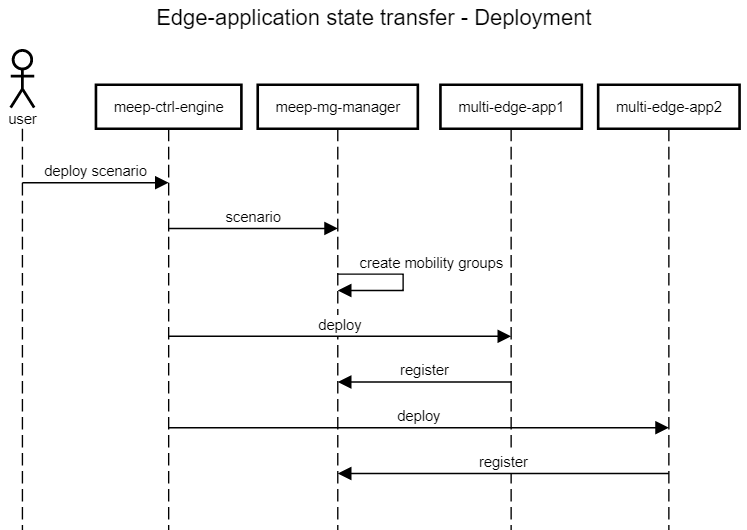Service Overview
AdvantEDGE provides a proprietary application state transfer service that facilitates state transfer between edge application instances.
This service provides the following capabilities:
- Creating & configuring a Mobility Group (MG)
- Registering edge applications to the MG
- Executing application state transfers
Micro-Services
- Mobility Group Manager: Implements a proprietary API with a custom integration with AdvantEDGE APIs
Northbound API
- Service API
- Mobility Group Manager API
- Documentation (markdown)
- Specification (yaml)
- Based on OpenAPI Specification (OAS) 2.0
- Mobility Group Manager API
- Related APIs
- Mobility Group Application API
- Sandbox Controller API
- Based on OpenAPI Specification (OAS) 2.0
AdvantEDGE Integration
AdvantEDGE provides a state transfer service that facilitates UE state transfer between instances of a multi-edge group.
To use the state transfer service, multi-edge application instances must:
- Create & Configure a Mobility Group (MG) using the MG Manager service REST API
Note: The MG is automatically created by the AdvantEDGE platform at scenario deployment time, based on the multi-edge group defined in the scenario; therefore, there is no need to create the MG via the MG Manager API. - Register to the MG using the MG Manager service REST API
- Implement the MG Application State Transfer REST API to handle MG application state events
When multi-edge application instances are registered to the MG, the MG Manager informs them when a UE state transfer is needed. They can then transfer the requested UE state to the target application instance(s) via the MG Manager service API.
Note: The MG Manager uses the MG configuration to determine when to send events and which events to send to the application instances.
MG Manager URIs
MG Manager REST API endpoint URIs are relative to: https://<platform-fqdn>/mgm/v1
Mobility Group Application REST API endpoint URIs are relative to the URL provided at MG application registration.
Mobility Group Creation
Mobility Groups are automatically created at scenario deployment time based on the multi-edge groups defined in the scenario.
The MG Manager service REST API endpoints used to create and configure MGs are the following:
- /mg
- /mg/{mgName}
Note: The MG Manager currently supports only the default configuration. DO NOT use this API to set a different configuration.
The AdvantEDGE platform uses the following default MG configuration:
| MG Config Param | Default Value | Description |
|---|---|---|
| stateTransferMode | STATE-MANAGED | MG Manager is used to transfer UE state |
| stateTransferTrigger | NET-LOC-IN-RANGE | The following state transfer events are sent to trigger UE state transfer: ● STATE-TRANSFER-START: - Sent when UE is in range of a POA with a different edge service instance - Triggered by a POAS-IN-RANGE event sent to Sandbox Controller ● STATE-TRANSFER-COMPLETE: - Sent when UE moves to a POA with a different edge service instance - Triggered by a UE-MOBILITY event sent to Sandbox Controller ● STATE-TRANSFER-CANCEL: - Sent when UE is no longer in range of a POA with a different edge service - Triggered by a POAS-IN-RANGE event sent to Sandbox Controller |
| sessionTransferMode | FORCED | Session between UE & Edge App instance is forcefully dropped after STATE-TRANSFER-COMPLETE event |
| loadBalancingAlgorithm | HOP-COUNT | Target multi-edge app instance is determined using minimum hop count to reach service |
Multi-Edge Application Instance Registration
The MG Manager service REST API endpoints used for multi-edge application instance registration are the following:
- /mg/{mgName}/app
- /mg/{mgName}/app/{appId}
The following figure presents the MG creation and application instance registration procedure.

- On scenario deployment, MG Manager service creates the Mobility Group(s)
- Sandbox Controller (via the Virt Engine) deploys the multi-edge application instances
- Upon start-up, multi-edge application instances register to the MG Manager
- POST /mg/multi-edge-svc/app/multi-edge-app1
- POST /mg/multi-edge-svc/app/multi-edge-app2
State Transfer on UE Mobility
The MG Manager service REST API endpoint used for transferring edge application UE state is the following:
- /mg/{mgName}/app/{appId}/state
The MG Application REST API endpoint used for handling UE state transfer events is the following:
- /mg/event
The AdvantEDGE Sandbox Controller REST API endpoint used for injecting UE Mobility events is the following:
- /events
The following figure presents the UE State Transfer procedure.

- At connection time, UE traffic is routed to the closest multi-edge app instance (multi-edge-app1)
- A UE Mobility event is sent to the Sandbox Controller to simulate a change of POA
- POST /events {UE-MOBILITY}
- MG Manager processes change of POA and determines that UE is now closest to a new multi-edge app instance (multi-edge-app2)
- MG Manager sends a state transfer event on the initial multi-edge app instance (multi-edge-app1)
- POST /mg/event {STATE-TRANSFER-COMPLETE}
- Initial multi-edge app instance (multi-edge-app1) sends its latest UE state to the MG Manager
- POST /mg/multi-edge-svc/app/multi-edge-app1/state {UE, state}
- MG Manager sends the UE state to the new multi-edge app instance (multi-edge-app2)
- POST /mg/event {STATE-UPDATE}
- MG Manager forcefully terminates the UE connection to the initial multi-edge app instance (multi-edge-app1)
- The UE should create a new connection to the multi-edge service, which will be routed to the new multi-edge app instance (multi-edge-app2)
State Transfer on PoAs in Range Event
Note: In cases where UE state transfer is required before a UE Mobility event occurs, the MG Manager service may be used to trigger a state transfer on a AdvantEDGE Sandbox Controller POAS-IN-RANGE event. This is the default MG Manager behavior, however the Demo Applications provided with the AdvantEDGE platform do not use this functionality. More details will be provided at a later time or upon request.